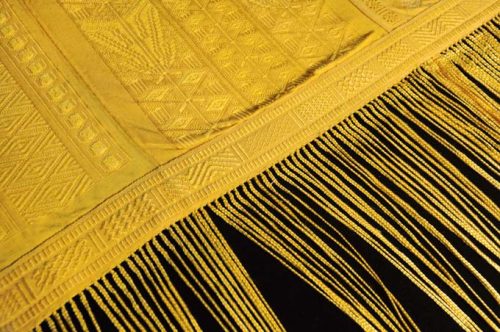I need this:
It’s spidercloth, a single piece of silky fabric made from silk drawn from a million spiders. It might be a little bit labor intensive.
To produce this unique golden cloth, 70 people spent four years collecting golden orb spiders from telephone poles in Madagascar, while another dozen workers carefully extracted about 80 feet of silk filament from each of the arachnids. The resulting 11-foot by 4-foot textile is the only large piece of cloth made from natural spider silk existing in the world today.
So I can’t pick up a spidercloth cloak at Target?
We’re going to have to figure out the chemistry, and we also have to figure out the machinery in spinnerets.
Of course, spending four years to produce a single textile of spider silk isn’t very practical for scientists trying to study the properties of spider silk or companies that want to manufacture the fabric for use as a biomedical scaffold or an alternative to Kevlar armor. Several groups have tried inserting spider genes into bacteria (or even cows and goats) to produce silk, but so far, the attempts have been only moderately successful.
Part of the reason it’s so hard to generate spider silk in the lab is that it starts out as a liquid protein that’s produced by a special gland in the spider’s abdomen. Using their spinnerets, spiders apply a physical force to rearrange the protein’s molecular structure and turn it into solid silk.
Well? Get right on that!




Just get the DoD curious about that flexible armor thing and funding will never be a problem again.
That must have been some piece of work, weaving all the spider silk together like that. Pretty awesome!
Now go and catch some flies with that :P
I’d be impressed if you could load it into a web shooter.
I must admit that I’m a little disappointed that apparently they did not weave a spider image into the cloth. Then again, I wasn’t able to find any pictures of the whole thing at once, so maybe it’s just in a section not pictured.
Spider silk tweeters? Talk about “high-end” gear. At least they’ll likely not be nearly as sticky as the ones on these ADS L-series speakers.
Using their spinnerets, spiders apply a physical force to rearrange the protein’s molecular structure …
Spinnerets implement nanotechnology?!?
@6
and those spinnerets can produce silk with different properties depending on what is needed at the time!
uncle frogy
If only we knew someone with a bunch of spiders on hand to study.
Is kneading dough to align gluten strings at all close to an accurate analogy for what spinnerets are doing to create silk strands?
“Part of the reason it’s so hard to generate spider silk in the lab is that it starts out as a liquid protein that’s produced by a special gland in the spider’s abdomen.”
It can’t be that difficult. A teenager could figure out how to do it in his bedroom in the 60s, for cryin’ out loud, so surely a bunch of eggheads with the best modern lab equipment can.
Waitaminute…spider genes in cows?!?! First we are going to have to reinforce all the barns so they can handle the weight of a cow in a web up in the rafters, then someone should call the SyFy network with this idea. Spider-cow, Spider-cow vs. Sharknado, Spider-cow II the web-e-ning…the (low quality CGI) movie titles write themselves!
There are a couple of great video’s on this from the Art Institute of Chicago:https://youtu.be/LFF68_bME9E and the V&A UK:https://youtu.be/Fv1qq6ypiTk that will give you more details.
@10: Just wait until you find out what an actual weapons designer can do in a cave with a box of scraps.
Of course, this article has nothing on fiction, where a teenage girl with bug control powers can get a few hundred black widows to weave her a full spider-silk costume! (Worm, by wildbow)
Very cool! Not sure if people know this, but Madagascar has a fairly advanced silk-weaving culture. They weave wild silk from cocoons of native silkworms–the wife has a couple of scarves. Not as cool as spider silk, granted, but still.
@ rrutis1, # 11: Did you see the Simpsons movie that featured Spider Pig?
So, Golden Orb spiders next Madagascan species to go extinct?
This is SO amazing, If what I’ve read I’d true, spider silk should be stronger than Kevlar per unit of weight and biodegradable.
is true, pardon.
There was a commercial venture to make spider silk in 17th century France. The cloth was impressive, but they had serious production problems and lacked things like chemistry and physics to work them. The French were always big on new types of cloth. Where do you think we get denim (Nimes), diapers(Ypres) and inkle(L’Ingle) from? If it had worked out, we’d been wearing spider suits today.